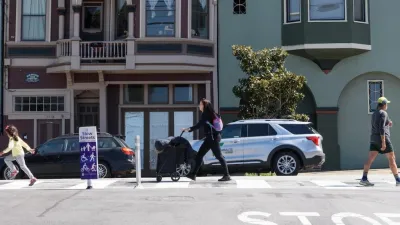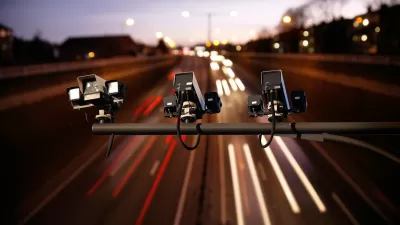The complete streets movement calls for streets to be designed—or redesigned—in order to accommodate a broad range of users and uses.

By Josh Stephens
In many ways, it is easier to describe what a complete street isn’t than what it is. A non-complete street primarily serves the through-put of automobiles. If pedestrians, bicyclists, transit riders, and diners at sidewalk cafes can use streets too without risking bodily harm or aesthetic offense, so be it. But those uses are, on the vast majority of American streets, incidental.
A new movement has been fighting against this transportation myopia. The complete streets movement calls for streets to be designed—or redesigned—in order to accommodate a broad range of users and uses. Bike lanes make streets more complete. So do enhanced crosswalks, lands aping, and sidewalks that accommodate disabled people. The possibilities are endless for cities that want to save lives and choose to view their streets as more than just thoroughfares.
“Every time you touch the transportation system, you should consider complete streets,” said Emiko Atherton, executive director of the National Complete Streets Coalition (NCSC). “It’s about changing the way we look at transportation planning.”
Traffic calming measures like bumps, humps, curves, bollards, roundabouts, and chicanes—obstacles or curves deliberately placed in the flow of automobile traffic—can make streets more complete. So can dedicated lanes for transit and enhanced stops. Improved signage and pavement markings make streets more complete. In commercial areas, widened sidewalks and shade trees make them more complete. Two-way streets are preferable to one-way streets.
At its most extreme, a complete street might be a woonerf. Devised in the Netherlands, a woonerf does away with all features that privilege the automobile over other forms of transportation. Usually narrow and intricately landscaped, every centimeter of a woonerf can be occupied by any type of user. Traffic does not necessarily flow quickly, but it flows pleasantly and safely.
But streets don’t have to go full woonerf to be more complete. There is no such thing as “a” complete street. No single street is “complete.” Complete streets encompasses more of an idea—and an attitude—than a typology.
Even in the United States, that attitude is catching on.
To read the full article, click here to visit InTransition magazine's website.
FULL STORY: Creating Complete Streets

Alabama: Trump Terminates Settlements for Black Communities Harmed By Raw Sewage
Trump deemed the landmark civil rights agreement “illegal DEI and environmental justice policy.”

Study: Maui’s Plan to Convert Vacation Rentals to Long-Term Housing Could Cause Nearly $1 Billion Economic Loss
The plan would reduce visitor accommodation by 25% resulting in 1,900 jobs lost.

Planetizen Federal Action Tracker
A weekly monitor of how Trump’s orders and actions are impacting planners and planning in America.

Waymo Gets Permission to Map SF’s Market Street
If allowed to operate on the traffic-restricted street, Waymo’s autonomous taxis would have a leg up over ride-hailing competitors — and counter the city’s efforts to grow bike and pedestrian on the thoroughfare.

Parklet Symposium Highlights the Success of Shared Spaces
Parklets got a boost during the Covid-19 pandemic, when the concept was translated to outdoor dining programs that offered restaurants a lifeline during the shutdown.

Federal Homelessness Agency Places Entire Staff on Leave
The U.S. Interagency Council on Homelessness is the only federal agency dedicated to preventing and ending homelessness.
Urban Design for Planners 1: Software Tools
This six-course series explores essential urban design concepts using open source software and equips planners with the tools they need to participate fully in the urban design process.
Planning for Universal Design
Learn the tools for implementing Universal Design in planning regulations.
Caltrans
Smith Gee Studio
Institute for Housing and Urban Development Studies (IHS)
City of Grandview
Harvard GSD Executive Education
Toledo-Lucas County Plan Commissions
Salt Lake City
NYU Wagner Graduate School of Public Service





























